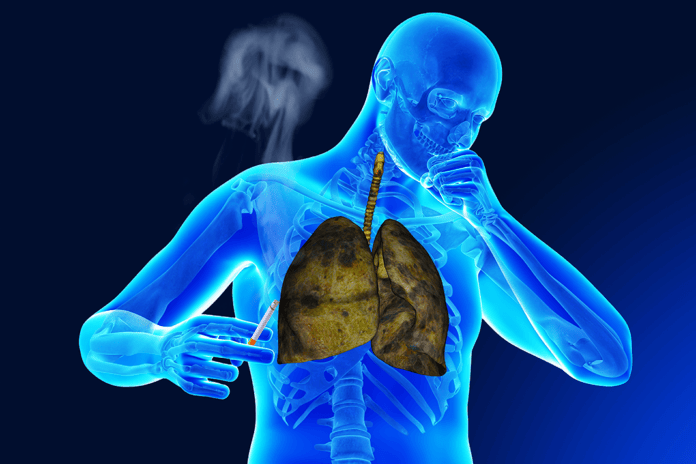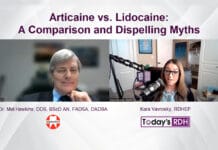When patients usually think of cancer in a dental setting, the initial thought is oral cancer. As a hygienist, I incorporate an intraoral cancer screening on every patient, examining the tissues of the oral cavity and looking for anything abnormal. Occasionally, a patient will comment, “Doesn’t oral cancer only happen when you use tobacco?” This is an opportunity to educate the patient on the many risk factors of oral cancer outside of tobacco use, such as human papillomavirus (HPV), alcohol consumption, etc.
After this, the conversation usually moves on to a different topic, and I feel like I have briefly educated the patient on oral cancer. However, recently more research is being conducted showing that periodontal disease could increase the risk of cancers outside of the mouth, such as lung cancer and colorectal cancer. Keeping up to date with this research allows dental hygienists to expand the “cancer talk” to places in the body other than the mouth, as well as reinforce the systemic link between gum disease and overall health.
Like oral cancer, most patients associate lung cancer with tobacco use and many think they do not possess a risk for lung cancer if they do not use tobacco.
What most patients do not know is that lung cancer is the leading cause of death from cancer in the United States, according to the National Cancer Institute, with more than 158,000 deaths per year.1 While using tobacco greatly increases the chances of developing lung cancer, current studies suggest an additional factor could be periodontal disease.
The Journal of Periodontology published an article titled “Periodontal Disease and Incident Lung Cancer Risk: A Meta-Analysis of Cohort Studies” focused on the link between periodontal disease and lung cancer.2 Initially, I was not surprised at the correlation, assuming that people who use tobacco are more likely to develop both lung cancer and periodontal disease, so the correlation between the two makes sense. However, researchers took participants with a history of tobacco and alcohol use and separated them from participants who had never used tobacco or had significant alcohol consumption. They noted there was still an increased risk of lung cancer in these non-tobacco using and low alcohol consumption patients; meaning that a person with no other risk factors for lung cancer could still have an increased risk of developing it, just from having periodontal disease alone.
A cohort study in this report suggested that certain bacteria from periodontal disease could be related to the development of cancer cells in the lungs and that successful treatment of periodontal disease may lead to a substantially lower lung cancer risk. Successful treatment of periodontal disease is what hygienists advocate for every single patient struggling with periodontal disease. Explaining that the bacteria that cause gum disease is linked to the development of cancer cells in the lungs can help patients understand that periodontal disease stretches far beyond just the mouth and that eliminating this bacteria is in their best interest.
In addition to lung cancer, studies have also pointed to periodontal disease as a risk factor for other types of cancer, like colorectal cancer. Colorectal cancer often begins when there is an increase of inflammation and a change in the microbiota in the gut. In a study published in Science Magazine, it was found that Fusobacterium, a bacteria found in periodontitis, was also present in malignant tissue samples from patients with colorectal cancer.3 Colorectal cancer is the third most common type of cancer in the United States and can be deadly if not treated early.
In the same study that linked periodontal disease to lung cancer, it was noted that researchers found an association between colorectal cancer and periodontal disease in patients who have never used tobacco.4 This continues to point to a connection between the inflammation and bacteria caused by severe periodontitis and cancers outside of the oral cavity.
Cancer is never a light topic to bring up in the operatory, but as research continues to link periodontal disease to cancer, it should be included in hygienists discussions with patients. Many patients initially do not realize the severity of periodontal disease and how inflammation and immunity plays a large role in overall health. Sharing how bacteria found in periodontal disease is connected to bacteria found in certain cancers, like lung and colorectal cancer, will help patients understand why keeping good oral hygiene habits is beneficial to the health of their entire body. To the general public, bleeding gums might not seem serious, but if we can explain that periodontal disease has potentially serious connections, like cancer, patients may understand that periodontal disease can affect much more than just the gums.
Now Listen to the Today’s RDH Dental Hygiene Podcast Below:
References
- Lung Cancer. National Cancer Institute. https://www.cancer.gov/types/lung
- American Academy of Periodontology https://www.perio.org/consumer/gum-disease-lung-cancer-risk
- Bullman, S. et al. Analysis of Fusobacterium persistence and antibiotic response in colorectal cancer. Science 358, 1443–1448 (2017).
- Michaud, D.S., Lu, J., Peacock-Villada, A.Y., Barber, J.R., Joshu, C.E., Prizment, A.E., Beck, J.D., Offenbacher, S., Platz, E.A. Periodontal disease assessed using clinical dental measurements and cancer risk in the ARIC study. Journal of the National Cancer Institute (JNCI). Published online Jan. 12, 2018.












